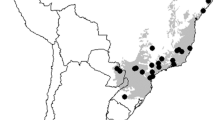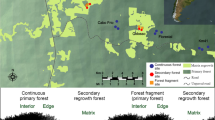Summary
In this paper I compare several biogeographic patterns of West Indian resident land birds and bats, including species-area and trophic diversity-area relationships, the number of islands inhabited per species and levels of endemism, trophic structure as compared with tropical mainland areas, and the degree of faunal simlarity between islands of similar sizes but different locations. In most respects, the bat and bird patterns are strikingly similar. Groups of birds that are conspicuously missing from the Antilles because of the absence of appropriate resources also have missing chiropteran counterparts. Plant-visiting bats and birds are better-represented in terms of relative number of species and, in birds, in biomass, on the Lesser Antilles than on the mainland (e.g. Panama). Small Antillean islands tend to share more species of birds and bats than do larger islands. Stochastic (sensu Simberloff 1978), deterministic, and interactive (e.g. competitive and trophic interactions) factors appear to underly these biogeographic trends. No evidence exists to suggest that Caribbean bats and birds have negatively affected each other's diversity.
Similar content being viewed by others
References
Allan JD, Barnthouse LW, Prestbye RA, Strong DR (1973) On foliage arthropod communities of Puerto Rican second growth vegetation. Ecology 54:628–632
Andrews RM (1979) Evolution of life histories: a comparison of Anolis lizards from matched island and mainland habitats. Breviora No. 454:1–51
Baker RJ, Genoways HH (1978) Zoogeography of Antillean bats. Pp 53–97 in FB Gill ed. Zoogeography in the Caribbean. Philadelphia Acad Nat Sciences Spec Pub No. 13
Beard JS (1949) The natural vegetation of the Windward and Leeward islands. Oxford Forestry Memoirs No. 21:1–192
Bonaccorso FJ (1979) Foraging and reproductive ecology in a Panamanian bat community. Bull Florida State Mus Biol Ser 24:359–408
Bond J (1971) Birds of the West Indies. Second ed Houghton Mifflin, Boston
Bradbury JW, Vehrencamp SL (1976) Social organization and foraging in emballonurid bats. I. Field studies. Behav Ecol Sociobiol 1:337–381
Brown JH, Davidson DW (1977) Competition between seed-eating rodents and ants in desert ecosystems. Science 196:880–882
Carlquist S (1965) Island life. Natural History Press, Garden City, New York
Christman RA (1953) Geology of St. Bartholomew, St. Martin, and Anguilla, Lesser Antilles. Bull Geol Soc Amer 64:65–96
Connor EF, Simberloff DS (1979) The assembly of species communities: chance or competition? Ecology 60:1132–1140
Dammerman KW (1948) The fauna of Krakatau 1883–1933. Verhandel Koninkl Ned Akad Wetenschap Af de Natuurk 44:1–594
Diamond JM (1975) Assembly of species communites. Pp 342–444 In: ML Cody, JM Diamond (eds), Ecology and evolution of communities. Belknap, Cambridge, Mass
Diamond JM, Marshall AG (1977) Distributional ecology of New Hebridian birds: a species kaleidoscope. J Anim Ecol 46:703–727
Faaborg J (1977) Metabolic rates, resources, and the occurrence of nonpasserines in terrestrial avian communities. Amer Natur 111:903–916
Fenton MB, Fleming TH (1976) Ecological interactions between bats and nocturnal birds. Biotropica 8:104–110
Fleming TH (1979) Do tropical frugivores compete for food? Amer Zool 19:1157–1172
Gardner AL (1977) Feeding habits. Pp 293–350 In: RJ Baker, JK Jones, Jr, and DC Carter (eds), Biology of bats of the New World family Phyllostomatidae. Pt 2. Spec Pub Museum Texas Tech University 13
Handley CO Jr (1966) Checklist of the mammals of Panama. Pp 753–795 In: RL Wenzel, VJ Tipton (eds), Ectoparasites of Panama. Field Museum Natur Hist Chicago
Humphrey SR (1975) Nursery roosts and community diversity of Nearctic bats. J Mammal 56:321–346
Janzen DH (1973) Sweep samples of tropical foliage insects: effects of seasons, vegetation types, elevation, time of day, and insularity. Ecology 54:687–702
Lack D (1976) Island biology, University of California Press, Berkeley
MacArthur RH, Wilson EO (1967) The theory of island biogeography. Monogr Pop Biol No 1 Princeton Univ Press Princeton
McNab BK (1969) The economics of temperature regulation in neotropical bats. Comp Biochem Physiol 31:227–268
McNab BK (1971) The structure of tropical bat faunas. Ecology 52:352–358
Ridgely RS (1976) A guide to the birds of Panama. Princeton Univ Press Princeton
Simberloff DS (1974) Equilibrium theory of island biogeography and ecology. Ann Review Ecol System 5:161–182
Simberloff DS (1978) Using island biogeographic distributions to determine if colonization is stochastic. Amer Natur 112:713–726
Simberloff DS, Wilson EO (1969) Experimental zoogeography of islands: the colonization of empty islands. Ecology 50:278–296
Sorenson T (1948) A method of establishing groups of equal amplitude in plant sociology based on similarity of species content. Det Kong Danske Vidensk Selsk Biol Skr 5:1–34
Snow DW (1971) Evolutionary aspects of fruit-eating by birds. Ibis 113:194–202
Terborgh JW (1973) Chance, habitat and dispersal in the distribution of birds in the West Indies. Evolution 27:338–349
Terborgh JW, Faaborg J (1980) Saturation of bird communities in the West Indies. Amer Natur 116:178–195
Terborgh JW, Faaborg J, Brockman HJ (1978) Island colonization by Lesser Antillean birds. Auk 95:59–72
Tuttle MD (1976) Collecting techniques. Pp 71–88 In: RJ Baker, JK Jones Jr, DC Carter (eds), Biology of bats of the New World family Phyllostomatidae Pt 1 Spec Pub Museum Texas Tech Univ 13
Willis EO, Eisenmann E (1979) A revised list of birds of Barro Colorado Island, Panama. Smithson Contrib Zool 291:1–31
Wilson DE (1973) Bat faunas: a trophic comparison. System Zool 22:14–29
Wright SJ (1979) Competition between insectivorous lizards and birds in central Panama. Amer Zool 19:1145–1156
Wright SJ (1981) Extinction-mediated competition: the Anolis lizards and insectivorous birds of the West Indies. Amer Natur 117:181–192
Author information
Authors and Affiliations
Rights and permissions
About this article
Cite this article
Fleming, T.H. Parallel trends in the species diversity of west indian birds and bats. Oecologia 53, 56–60 (1982). https://doi.org/10.1007/BF00377136
Received:
Issue Date:
DOI: https://doi.org/10.1007/BF00377136




